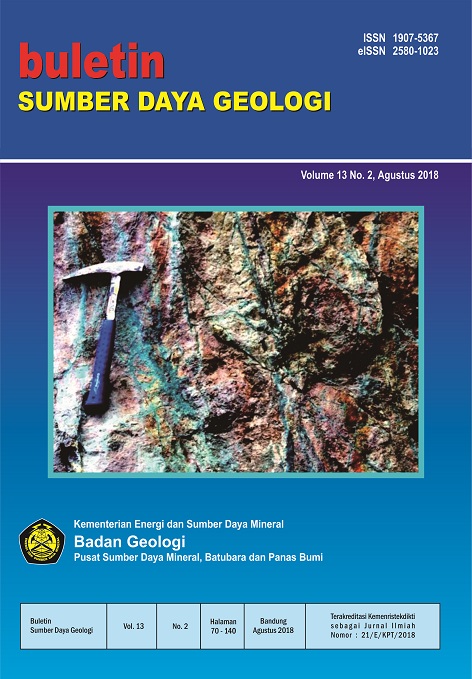PEMODELAN RESEVOIR PANAS BUMI DAERAH DUA SAUDARA, KOTA BITUNG, PROVINSI SULAWESI UTARA, DENGAN MENGGUNAKAN INVERSI 2-D DATA MAGNETOTELURIK
Abstract
Hasil survei geologi, geokimia dan geofisika gaya berat dan TDEM, di daerah panas bumi Dua Saudara, Kota Bitung, Provinsi Sulawesi Utara belum dapat secara akurat mendelineasi area dan dimensi prospek panas bumi di daerah ini. Sistem panas bumi di daerah ini berasosiasi dengan aktivitas vulkanik Gunung Tangkoko-Batuangus berumur Kuarter. Litologi daerah ini didominasi oleh endapan vulkanik berupa piroklastik dan lava. Selain batuan teralterasi, mata air panas muncul dengan temperatur 34°C -61°C, dari fluida air panas didapat penghitungan temperatur bawah permukaan mencapai 150°C. Pemodelan 2D inversi dilakukan pada data survei Magnetotelurik di 35 titik ukur dengan spasi 1000 hingga 1500 m yang difokuskan di lokasi manifestasi mata air panas. Hasil inversi menggunakan perangkat lunak WinGLink menunjukkan adanya lapisan resistivitas rendah (<10 ohm-m) yang ditafsirkan sebagai lapisan penudung dari system panas bumi Dua Saudara. Lapisan ini berasosiasi dengan lapisan konduktif yang terletak pada kedalaman sekitar 750 meter hingga 1000 meter. Zona resistivitas tinggi (25-100 ohm-m) ditafsirkan sebagai batuan panas yang kemungkinan adalah reservoir dari sistem tersebut. Dari model ini disimpulkan bahwa daerah survei masih merupakan zona outflow, sedangkan zona upflow diduga ke arah tenggara menuju Gunung Dua Saudara dan Gunung Tangkoko.
Downloads
References
Anonim, 2013a, ‘Laporan Survei Terpadu Geologi dan Geokimia Daerah Panas Bumi Dua Saudara, Kota Bitung, Provinsi Sulawesi Utara.’ Pusat Sumber Daya Geologi, Badan Geologi, Kementerian Energi dan Sumber Daya Mineral Indonesia. (Unpubl. Report).
Anonim, 2013b, ‘Laporan Survei Geofisika Terpadu Daerah Panas Bumi Dua Saudara, Kota Bitung, Provinsi Sulawesi Utara.’ Pusat Sumber Daya Geologi, Badan Geologi, Kementerian Energi dan Sumber Daya Mineral Indonesia. (Unpubl. Report).
Cagniard, L.,1953. Basic theory of the magnetotelluric method of geophysical prospecting. Geophysics 18: 605–645.
Cumming, & Mackie, R., 2010. Resistivity Imaging of Geothermal Resources Using 1D, 2D and 3D MT Inversion and TDEM Static Shift Correction Illustrated by a Glass Mountain Case History, Proceeding World Geothermal Congress, 2010.
Daud Y., 2010, Diktat kuliah: Metode Magnetotelluric (MT), Laboratorium Geofisika, FMIPA Universitas Indonesia.
Jones, A. G., A. D. Chave, G. Egbert, D. Auld, and K. Bahr, 1989: A comparison of techniques for magnetotellu¬ric response function estimation. J. Geophys. Res., 94, 14201-14213, doi:10.1029/jb094ib10p14201.
Qahhar A, Daud Y, Pratama S, Zarkasyi A, Sugiyanto A, Suhanto E, 2015, Modeling of Geothermal Reservoir in Lawu field Using 2-D Inversion of Magnetotelluric Data, Proceedings Indonesia International Geothermal Convention & Exhibition
Siripunvaraporn, W., G. Egbert, Y. Lenbury, and M. Uye¬shima, 2005a: Three-dimensional magnetotelluric in¬version: Data-space method. Phys. Earth Planet. Inter., 3D Resisvitity Structure in the Chingshui Geothermal Area 281 150, 3-14, doi: 10.1016/j.pepi.2004.08.023.
Siripunvaraporn W.,2012. Three-Dimensional Magnetotelluric Inversion: An Introductory Guide for Developers and Users. SurvGeophys 33:5-27.
Zhdanov, M.S., 2002. Geophysical Inverse Theory and Regularization Problems. Amsterdam: Elsevier.
Zhdanov, M.S., 2009. Geophysical Electromagnetic Theory and Methods. Amsterdam: Elsevier.
Copyright (c) 2018 Buletin Sumber Daya Geologi

This work is licensed under a Creative Commons Attribution-NonCommercial-ShareAlike 4.0 International License.
Authors whose manuscripts are published agree to the following terms:
The publication rights of all journal manuscript materials published on the Buletin Sumber Daya Geologi website are held by the editorial board with the knowledge of the author (moral rights remain with the manuscript’s author).
The formal legal provisions for access to digital articles in this electronic journal are subject to the terms of the Creative Commons Attribution-ShareAlike (CC BY-SA) license. This means that Buletin Sumber Daya Geologi has the right to store, convert media/formats, manage in the form of a database, maintain, and publish the article without requesting permission from the author, as long as the author’s name is cited as the copyright holder.
Manuscripts published in both print and electronic formats are open access for educational, research, investigative, and library purposes. Beyond these purposes, the editorial board is not responsible for any violations of copyright law.















